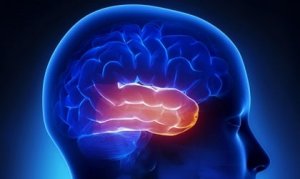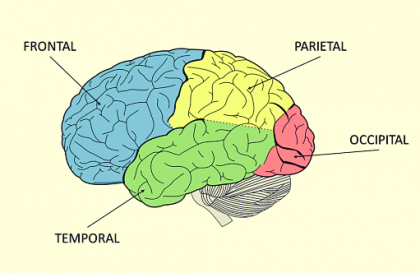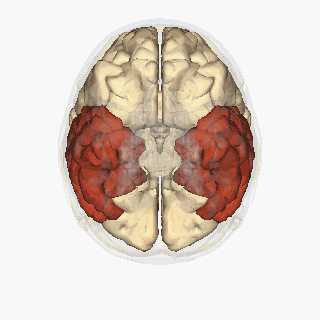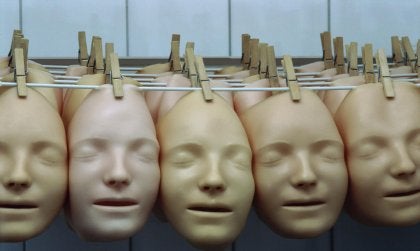The Temporal Lobe: The Center of Memory and Emotions


Written and verified by the psychologist Valeria Sabater
Communicating effectively. Reading and writing. Remembering the kiss your partner gave you this morning. Experiencing sexual desire. Trying to take care of your emotional stability. Knowing how to use a book or an elevator. Getting emotional during a movie. Believe it or not, the temporal lobe is responsible for regulating all of these diverse processes.
Heraclitus said that nothing in nature is stable, that everything changes and flows, including the tissues of the body. There’s one constant though, and that’s the feeling that you’re always the same person. This internal perception of a fixed and invariable self is something that most of us share.
In spite of that feeling, the cells in your body aren’t the only things that are changing and regenerating all the time. Every one of your mental processes, every lesson, experience, sensation, and emotion affect your brain.
The temporal lobe happens to be the area of the brain that supports these changes the most. That’s because it helps you learn, remember, motivate yourself, process information, and form emotional bonds to adapt to your surroundings.
Changes to the temporal lobe
Because the temporal lobe is so important, any injury to that area can have serious consequences. Experts in the field such as Dr. Francisco J. Rubia at the University of Dusseldorf and author of books such as El Cerebro Nos Engaña, ¿Qué Sabes De Tu Cerebro? (In English: Brain Tricks, What Do You Know About Your Brain?) and El Cerebro Espiritual (In English: The Spiritual Brain) explains that damage to the temporal lobe can have even stranger consequences than you might imagine.
Edgar Allan Poe illustrated one of these consequences in his classic work William Wilson. The feeling of having a double is called “autoscopy” and involves temporal lobe damage.

Where’s the temporal lobe?
The temporal lobe is more or less where your ears are. It’s separated from the parietal lobe by the lateral sulcus (also known as the Sylvian fissure). Scientists believe that it’s one of the newer parts of the brain because only vertebrates have it.
Similar to other areas of the brain, the temporal lobe isn’t anatomically isolated. It works in conjunction with all the other areas of the brain. This particular lobe is a very dynamic, sensitive structure that’s in constant interaction with the senses and your surroundings.
One interesting fact is that the temporal lobe has more connections with the limbic system than any other lobe in the brain. Consequently, it’s responsible for a large number of processes related to emotions and memory.
The distinct areas and functions of the temporal lobe
The temporal lobe has a right and left hemisphere, just like other brain structures. It also has a series of interconnected structures that enable certain functions. The most well-known and studied are:
- Auditory perception.
- Memory.
- Speech.
- Language comprehension.
- Emotional response.
- Visual perception.
- Facial recognition.
Let’s take a more detailed look at where each of these processes takes place.

Auditory cortex
Perceiving sounds, understanding where they’re coming from, identifying musical sounds, being able to communicate effectively and coherently… The auditory cortex of the temporal lobe mediates all of these processes. This is also a crucial area for human communication.
Visual cortex
Your ability to recognize objects and faces, as well as all other visual stimuli, involves the visual cortex of the temporal lobe. Any damage to this structure can have serious side effects. It can permanently damage your ability to recognize and identify the things around you.
Wernicke’s area
Wernicke’s area is inside the auditory cortex and enables you to understand spoken language. It’s important to note that this area is only responsible for the comprehension of spoken language. Producing speech and communicating, however, happens in the Broca area.
Angular gyrus
Reading and writing, decoding symbols, understanding them, connecting graphemes with phonemes… All of these fine-tuned processes require a sophisticated ability to associate visual information with auditory information. This kind of activity takes place in the angular gyrus.
Supramarginal gyrus
Anticipating what you’ll feel before you touch an object or recognizing said object only through touch are processes that happen in the supramarginal gyrus. This small but powerful structure also makes it possible to experience the gratifying and pleasant sensations you get when you touch someone you love.

Parietal-temporal-occipital association cortex
As you can tell from its name, the parietal-temporal-occipital association cortex involves the temporal lobe, the parietal lobe, and the occipital lobe. Although scientists don’t yet fully understand this area of the brain, they do believe that it’s associated with the following processes:
- Spatial perception.
- Targeted attention.
- Visual-motor integration.
- The ability to situate and orient your body when you see a visual stimulus or hear a sound.
- Memoiristic processes (such as recognizing loved ones).
Temporal lobe alterations and disorders
As we’ve mentioned above, biologists and neurologists believe that the temporal lobe is one of the newest structures in the brain. It plays a role in communication, reading, writing, and more.
Add to that the connection with the limbic system, which helps control behavior, and you’ll understand both how important this area is and also how serious the consequences can be if the temporal lobe is damaged.
For example, one recent study from the MRC Brain Metabolism Unit at the Royal Edinburgh Hospital found that people with major depression have various alterations in the temporal lobe.
Injury to the temporal lobe has other implications, such as:
- Cortical deafness. When the individual can receive auditory information, but the brain can’t process it.
- Language disorders such as aphasias.
- Hemispatial neglect. Orientation problems and the inability to react to stimuli.
- Anterograde amnesia. Problems remembering new things and processing new experiences.
- Kluver-Bucy syndrome. People with Alzheimer’s often suffer from this syndrome. It’s characterized by passivity and attention problems. Kluver-Bucy syndrome can also cause serious emotional regulation issues.
- Capgras syndrome. Patients with this disorder suffer from delusions that a close friend or family member has been “replaced”.

In conclusion, the temporal lobe is responsible for countless tasks that help you live your day-to-day life. Thanks to the temporal lobe, you know who you are and you can adapt to your surroundings. It also allows you to carry out distinctly human activities such as writing, reading, and communicating.
Communicating effectively. Reading and writing. Remembering the kiss your partner gave you this morning. Experiencing sexual desire. Trying to take care of your emotional stability. Knowing how to use a book or an elevator. Getting emotional during a movie. Believe it or not, the temporal lobe is responsible for regulating all of these diverse processes.
Heraclitus said that nothing in nature is stable, that everything changes and flows, including the tissues of the body. There’s one constant though, and that’s the feeling that you’re always the same person. This internal perception of a fixed and invariable self is something that most of us share.
In spite of that feeling, the cells in your body aren’t the only things that are changing and regenerating all the time. Every one of your mental processes, every lesson, experience, sensation, and emotion affect your brain.
The temporal lobe happens to be the area of the brain that supports these changes the most. That’s because it helps you learn, remember, motivate yourself, process information, and form emotional bonds to adapt to your surroundings.
Changes to the temporal lobe
Because the temporal lobe is so important, any injury to that area can have serious consequences. Experts in the field such as Dr. Francisco J. Rubia at the University of Dusseldorf and author of books such as El Cerebro Nos Engaña, ¿Qué Sabes De Tu Cerebro? (In English: Brain Tricks, What Do You Know About Your Brain?) and El Cerebro Espiritual (In English: The Spiritual Brain) explains that damage to the temporal lobe can have even stranger consequences than you might imagine.
Edgar Allan Poe illustrated one of these consequences in his classic work William Wilson. The feeling of having a double is called “autoscopy” and involves temporal lobe damage.

Where’s the temporal lobe?
The temporal lobe is more or less where your ears are. It’s separated from the parietal lobe by the lateral sulcus (also known as the Sylvian fissure). Scientists believe that it’s one of the newer parts of the brain because only vertebrates have it.
Similar to other areas of the brain, the temporal lobe isn’t anatomically isolated. It works in conjunction with all the other areas of the brain. This particular lobe is a very dynamic, sensitive structure that’s in constant interaction with the senses and your surroundings.
One interesting fact is that the temporal lobe has more connections with the limbic system than any other lobe in the brain. Consequently, it’s responsible for a large number of processes related to emotions and memory.
The distinct areas and functions of the temporal lobe
The temporal lobe has a right and left hemisphere, just like other brain structures. It also has a series of interconnected structures that enable certain functions. The most well-known and studied are:
- Auditory perception.
- Memory.
- Speech.
- Language comprehension.
- Emotional response.
- Visual perception.
- Facial recognition.
Let’s take a more detailed look at where each of these processes takes place.

Auditory cortex
Perceiving sounds, understanding where they’re coming from, identifying musical sounds, being able to communicate effectively and coherently… The auditory cortex of the temporal lobe mediates all of these processes. This is also a crucial area for human communication.
Visual cortex
Your ability to recognize objects and faces, as well as all other visual stimuli, involves the visual cortex of the temporal lobe. Any damage to this structure can have serious side effects. It can permanently damage your ability to recognize and identify the things around you.
Wernicke’s area
Wernicke’s area is inside the auditory cortex and enables you to understand spoken language. It’s important to note that this area is only responsible for the comprehension of spoken language. Producing speech and communicating, however, happens in the Broca area.
Angular gyrus
Reading and writing, decoding symbols, understanding them, connecting graphemes with phonemes… All of these fine-tuned processes require a sophisticated ability to associate visual information with auditory information. This kind of activity takes place in the angular gyrus.
Supramarginal gyrus
Anticipating what you’ll feel before you touch an object or recognizing said object only through touch are processes that happen in the supramarginal gyrus. This small but powerful structure also makes it possible to experience the gratifying and pleasant sensations you get when you touch someone you love.

Parietal-temporal-occipital association cortex
As you can tell from its name, the parietal-temporal-occipital association cortex involves the temporal lobe, the parietal lobe, and the occipital lobe. Although scientists don’t yet fully understand this area of the brain, they do believe that it’s associated with the following processes:
- Spatial perception.
- Targeted attention.
- Visual-motor integration.
- The ability to situate and orient your body when you see a visual stimulus or hear a sound.
- Memoiristic processes (such as recognizing loved ones).
Temporal lobe alterations and disorders
As we’ve mentioned above, biologists and neurologists believe that the temporal lobe is one of the newest structures in the brain. It plays a role in communication, reading, writing, and more.
Add to that the connection with the limbic system, which helps control behavior, and you’ll understand both how important this area is and also how serious the consequences can be if the temporal lobe is damaged.
For example, one recent study from the MRC Brain Metabolism Unit at the Royal Edinburgh Hospital found that people with major depression have various alterations in the temporal lobe.
Injury to the temporal lobe has other implications, such as:
- Cortical deafness. When the individual can receive auditory information, but the brain can’t process it.
- Language disorders such as aphasias.
- Hemispatial neglect. Orientation problems and the inability to react to stimuli.
- Anterograde amnesia. Problems remembering new things and processing new experiences.
- Kluver-Bucy syndrome. People with Alzheimer’s often suffer from this syndrome. It’s characterized by passivity and attention problems. Kluver-Bucy syndrome can also cause serious emotional regulation issues.
- Capgras syndrome. Patients with this disorder suffer from delusions that a close friend or family member has been “replaced”.

In conclusion, the temporal lobe is responsible for countless tasks that help you live your day-to-day life. Thanks to the temporal lobe, you know who you are and you can adapt to your surroundings. It also allows you to carry out distinctly human activities such as writing, reading, and communicating.
All cited sources were thoroughly reviewed by our team to ensure their quality, reliability, currency, and validity. The bibliography of this article was considered reliable and of academic or scientific accuracy.
- Baños, R. y Perpiña, C. (2002). Exploración Psicopatológica. Madrid: Síntesis.
- Belloch, A., Baños, R. y Perpiñá, C. (2008) Psicopatología de la percepción y la imaginación. En A. Belloch, B. Sandín y F. Ramos (Eds.) Manual de Psicopatología (2ª edición). Vol I. Madrid: McGraw Hill Interamericana.
- Carlson, N.R. (1999). Fisiología de la conducta. Barcelona: Ariel Psicología.
- Carpenter, M.B. (1994). Neuroanatomía. Fundamentos. Buenos Aires: Editorial Panamericana.
- Delgado, J.M.; Ferrús, A.; Mora, F.; Rubia, F.J. (eds) (1998). Manual de Neurociencia. Madrid: Síntesis.
- Diamond, M.C.; Scheibel, A.B. y Elson, L.M. (1996). El cerebro humano. Libro de trabajo. Barcelona: Ariel.
This text is provided for informational purposes only and does not replace consultation with a professional. If in doubt, consult your specialist.







